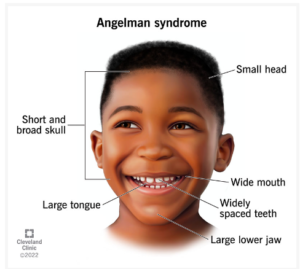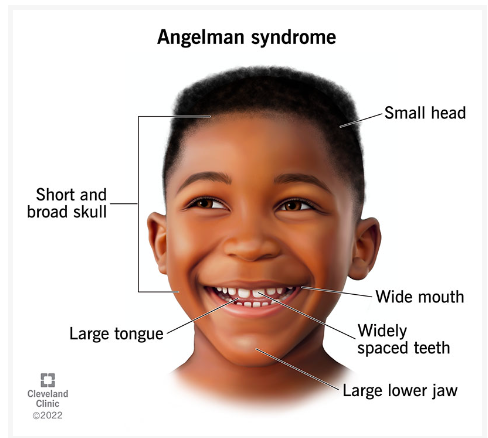Angelman Syndrome (AS) is a rare genetic disorder that profoundly affects the nervous system. This condition is marked by severe developmental delays, speech impairment, and distinctive physical and behavioral traits. In this blog, we explore the causes, symptoms, and available support for individuals and families impacted by this syndrome.
What is Angelman Syndrome?
Angelman Syndrome is a neurogenetic disorder that occurs in about 1 in 15,000 live births. Identified by Dr. Harry Angelman in 1965, this condition is caused by a mutation on chromosome 15, specifically affecting the UBE3A gene, which is essential for nervous system development and function.

Causes and Genetic Basis
The disorder typically arises from a deletion or mutation in the UBE3A gene on chromosome 15. This gene is critical for brain function. Most commonly, Angelman Syndrome results from a deletion of the maternal UBE3A gene. The absence of this gene’s function leads to the symptoms associated with the condition.
In rarer instances, it may be caused by mutations in the UBE3A gene or paternal uniparental disomy, where both copies of chromosome 15 are inherited from the father, leaving no functional maternal UBE3A gene.
Symptoms and Characteristics
The symptoms can vary but generally include:
- Developmental Delays: Children may experience delays in milestones like walking and talking.
- Speech Impairment: Most individuals are non-verbal or have very limited speech, often using alternative communication methods such as sign language or devices.
- Movement and Balance Issues: Ataxia (lack of muscle coordination) and tremors are common, impacting walking and balance.
- Physical Features: Distinctive traits may include a wide mouth, prominent teeth, and a generally happy or excitable demeanor.
- Behavioral Traits: Frequent laughter, an affinity for water, and hyperactivity or impulsivity are common.
- Seizures: These often begin in early childhood and require ongoing medical management.
Diagnosis and Genetic Testing
Diagnosing this syndrome involves evaluating clinical symptoms and characteristics. Genetic testing, including DNA methylation studies and UBE3A gene analysis, is used to confirm the diagnosis by identifying specific mutations or deletions. Early diagnosis is important for effective management.
Management and Support
While there is no cure, a comprehensive approach can improve quality of life. Key strategies include:
- Early Intervention: Therapies like physical, occupational, and speech therapy address developmental delays and improve communication.
- Medical Management: Ongoing medication and monitoring manage seizures and other health issues.
- Educational Support: Specialized programs aid cognitive and social development.
- Behavioral Therapy: Interventions help manage challenging behaviors and enhance social skills.
- Family Support: Counseling and support groups provide valuable help to families navigating caregiving challenges.
Research and Future Directions
Ongoing research focuses on understanding the genetic mechanisms of the disorder and developing potential treatments. Advances in gene therapy and pharmacological interventions offer hope for future therapies. Clinical trials and studies continue to explore ways to improve outcomes and quality of life.
Conclusion
Angelman Syndrome impacts various aspects of life. While there is no cure currently, early diagnosis and a comprehensive management plan can significantly enhance quality of life. Continued research and support are crucial for advancing treatment and understanding of this condition. Families and caregivers are encouraged to connect with support networks and access resources to navigate the challenges of Angelman Syndrome effectively.
ALSO TRY:https://lifesportsandhealth.com/olympic-sport-climbing-rise-key-moments/\
SUBSCRIBE TO GET MORE SUCH BLOGS


1 thought on ““Essential Guide: 5 Powerful Insights into Angelman Syndrome – Causes, Symptoms, and Support””